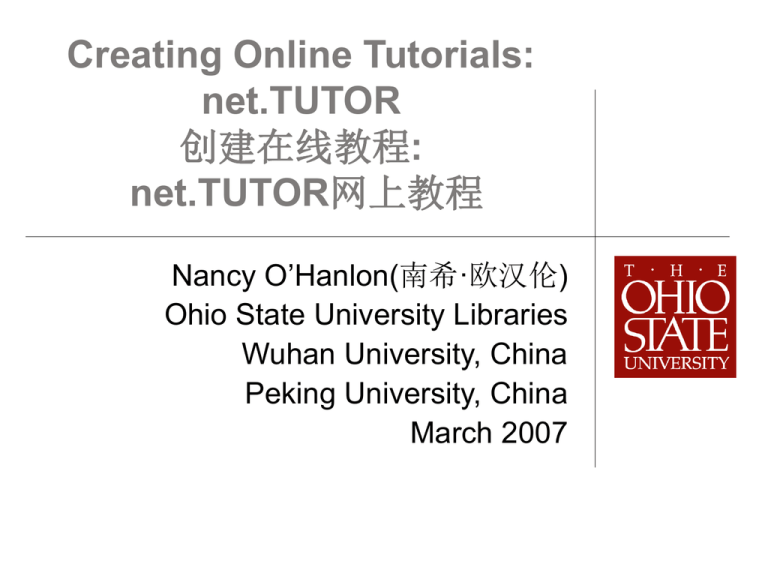Creating Online Tutorials: net.TUTOR :
advertisement

Creating Online Tutorials: net.TUTOR 创建在线教程: net.TUTOR网上教程 Nancy O’Hanlon(南希·欧汉伦) Ohio State University Libraries Wuhan University, China Peking University, China March 2007 Goals for Presentation 本次演示目的 1. Discuss net.TUTOR, an online tutorial program developed at Ohio State University Libraries. 讨论俄亥俄州立大学图书馆开发的在线教程程序net.TUTOR 2. Review the instructional design process for online tutorials. 评述在线教程的教学设计过程 3. Offer examples of specific techniques for effective teaching through tutorials. 提供利用在线教程进行有效教学所用的独特技术的一些例子 net.TUTOR: Brief History net.TUTOR简介 net. = TUTOR = Internet(网络) Teaching (教学) Useful (使用) Techniques for (技术) Online (在线) Research(研究) URL is http://liblearn.osu.edu/tutor net.TUTOR: Program Goals(软件目标) Teach Internet research concepts. 讲授互联网研究概念 Employ active learning principles. 采用主动学习原则 Allow self assessment, flexible selection of tasks, and channels for user comments. 允许自我评估、灵活选择任务、开拓用户评价渠道 Insure that essential information is available to all users. 确保基本信息能为所有用户使用 net.TUTOR: Users(用户) Individuals who desire self-paced learning. 具体用户,愿意自定学习进度的自学者 OSU faculty who make class assignments. 俄亥俄州立大学的教师,制作课堂作业者 OSU librarians who refer users to learn skills. 俄亥俄州立大学的图书馆员,为读者提供学 习方法和技能的人 Design Process: Overview (设计过程:概述) WHO: Identify audience 谁: 确定观众 WHAT: Assess instructional needs 什么: 评估教学需要 HOW: Select appropriate media, methods 怎样: 选择合适的媒体与方法 Design Process: Cycle 设计过程:循环周期 Develop Obtain feedback Prototype on usability (开发原型) (获取可用性测试的反馈信息) Redesign (重新设计) Design Process: Needs (设计过程:需求) What do users already know? 什么内容用户已经知悉? How should you focus your efforts? 该怎样确定主攻方向? Assess instructional needs of your audience through feedback from 通过听课人员的反馈信息评估教学需求 Teaching faculty (教师) Librarians(图书馆员) Students (potential users)(学生,或潜在用户) Design Process: Media (设计过程:媒体) Consider variations in user: 考虑用户的各种需求: Computers (operating system; speed) 计算机(操作系统;速度) Software (browsers) 软件(浏览器) Internet connections (fast/slow) 网络连接(快/慢) Design Process: Media 设计过程:媒体 Design for small interface (such as PDA or phone with Web access) will be different. 设计小界面,如用PDA或手机 登录网络的界面将会有所不同 QuizFaber uses WML for quiz creation. Available at http://www.download.com QuizFaber软件用WML语言创 建网上测验试卷。该软件可在 这个网址上下载 Design Process: Methods (设计过程:方法) Flexible design(灵活设计) Chunking(程序分块) Interactivity(交互性) Effective use of multimedia (有效利用多媒体) Teaching through strategies(讲究策略的教学方式) Design Process: Flexibility (设计过程:灵活性) Users can choose(用户可进行选择) Instructional tasks from a menu 可从菜单中选择教学任务 Portions of lessons 可选部分课程 Design process: Chunking (设计过程:程序分块) Divide information into logical segments. 将信息分成若干逻辑段 Sequence from simple to complex. 由简到繁的顺序 Label segments to help user understand their relation to each other. 帮助用户理解相互关系的分段标示名称 Example 举例 Design Process: Interactivity 设计过程:交互性 Engage the learner with the material in order to practice skills. 让学习者参与其中,获得实践技能 Implement in tutorials by providing 通过提供以下方法完成教学 Guided activities (and feedback) 指导学习活动(和回应学习者的反馈) Casual games(临时穿插学习游戏) Movies or animations(应用电影或动画技巧) Quiz questions(测验提问) Example: Interactivity 交互性的实例 Example: Interactivity 交互性的实例 Example: Interactivity 交互性的实例 Captivate movie 应用Captivate电影软件工具 Design Process: Multimedia (设计过程:多媒体) Universal Design for Learning (UDL) principles should guide tutorial design. 通用学习设计原则应能指导教学设计 Design products and environments to be usable by all people, to the greatest extent possible, without the need for adaptation or specialized design. 设计的项目和使用环境要尽可能适用于所有人,无需 改变或进行专门设计 Represent information in various ways to match user learning styles. 表达信息的各种方式应尽可能与用户的学习风格匹配 Example: Universal Design (举例:通用设计) Design Process: Strategies 设计过程:策略 Learning strategy: set of steps to accomplish a particular task. 学习策略:设计的措施和步骤应能完成指定的 任务 Concise 简明扼要 Use mnemonics to enhance recall 应用记忆法加强对学习内容的回忆 Examples: Research Skills 举例: 探索教学技巧 PAW Perform search in stages 分阶段进行检索 Avoid long phrases 避免使用太长的语句 Watch results for new terms 在结果中找出新的术语供检 索 BILS Browse keyword search results 浏览关键词搜索结果 Identify relevant record 确认相关记录 Look at subject headings 注意主题词 Search using subjects 用主题词进行检索 Design Process: Assessment 设计过程:评定 Self assessment – unscored quiz questions with immediate feedback to students. 自我评估—不记分测验提问,并即时反馈给学生 Formal assessment – secure online test with feedback to students and faculty. 正式评定—安全在线考试,考试成绩反馈给学生和教 师 Design Process: Evaluation 设计过程:评价 Components: 组成部分: User comment forms 用户评论表格 Web statistics 网站访问量 Conclusion: Benefits 结论:优点 Online tutorials are: 在线教程的优点 Cost effective 节省成本 Easily updated (but must maintain) 易于更新(但必须维护) Learning objects that can have multiple uses (such as online or traditional courses) 学习对象可以有多种用途(如网络联机或传统 的课程) Questions? 请提问 Thank you for your attention.



